Literature Review: FDI, Political Instability, and Developing Nations
VerifiedAdded on 2020/02/24
|37
|9986
|445
Report
AI Summary
This report presents a comprehensive literature review focusing on the role and impact of political instability in attracting Foreign Direct Investment (FDI) to developing countries. It begins by defining FDI and exploring its benefits, including economic growth, technology transfer, and improvements in labor resources. The review then delves into key theories of FDI, such as the monopolistic advantage theory, oligopoly theory, product life cycle model, and Dunning's eclectic paradigm, critically evaluating the latter. Determinants of FDI are examined, including market size, openness, labor costs, infrastructure, and institutional factors. The report also discusses various modes of entry for foreign firms and promotional strategies to attract FDI. A significant portion is dedicated to a case study of Yemen, analyzing its economy, FDI inflows, and the impact of political instability on investment. The research methodology, including research design, approach, philosophy, strategy, techniques, data collection, and analysis methods, is thoroughly explained. The report concludes with a discussion of research limitations and a summary of findings, providing a valuable resource for understanding the complex relationship between political stability and FDI in developing nations.
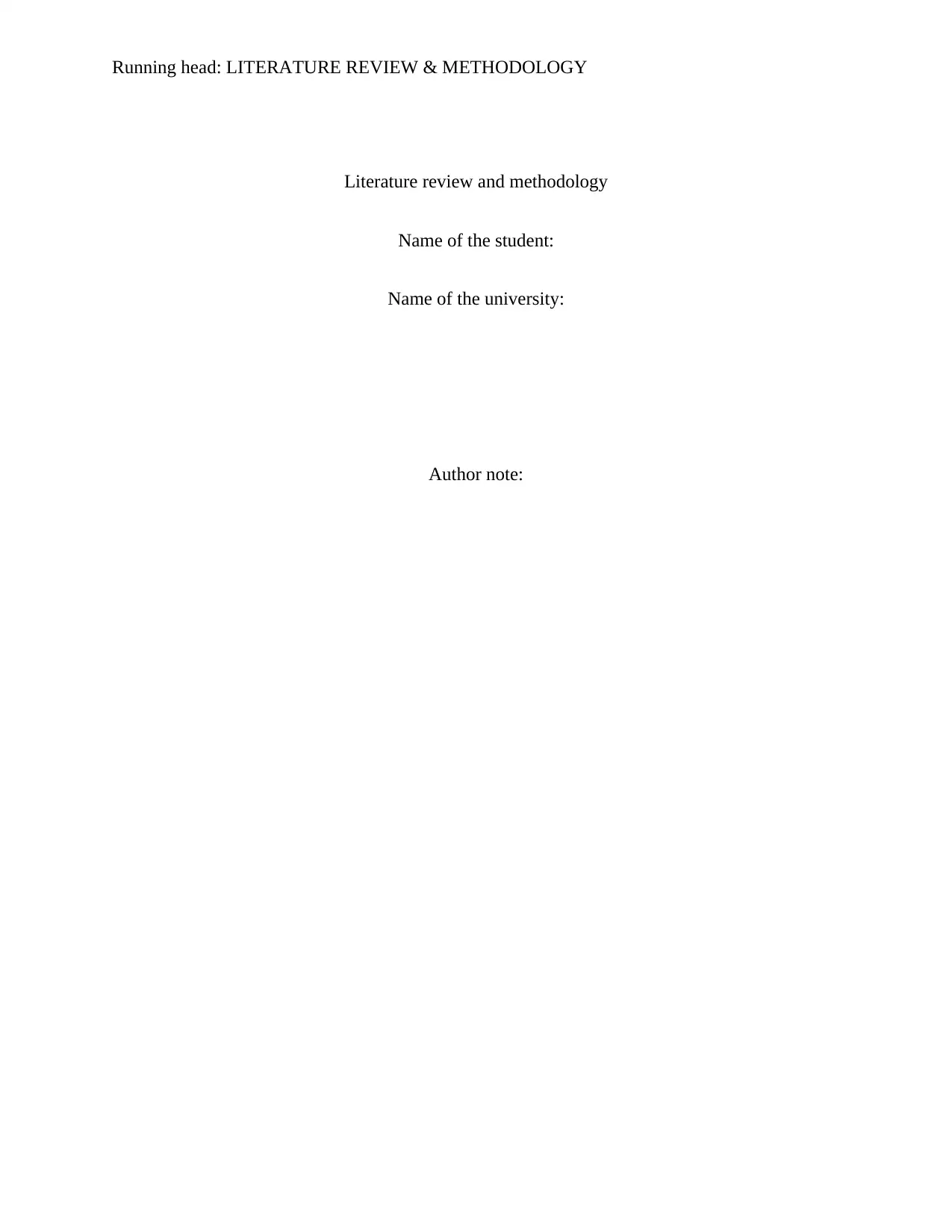
Running head: LITERATURE REVIEW & METHODOLOGY
Literature review and methodology
Name of the student:
Name of the university:
Author note:
Literature review and methodology
Name of the student:
Name of the university:
Author note:
Paraphrase This Document
Need a fresh take? Get an instant paraphrase of this document with our AI Paraphraser
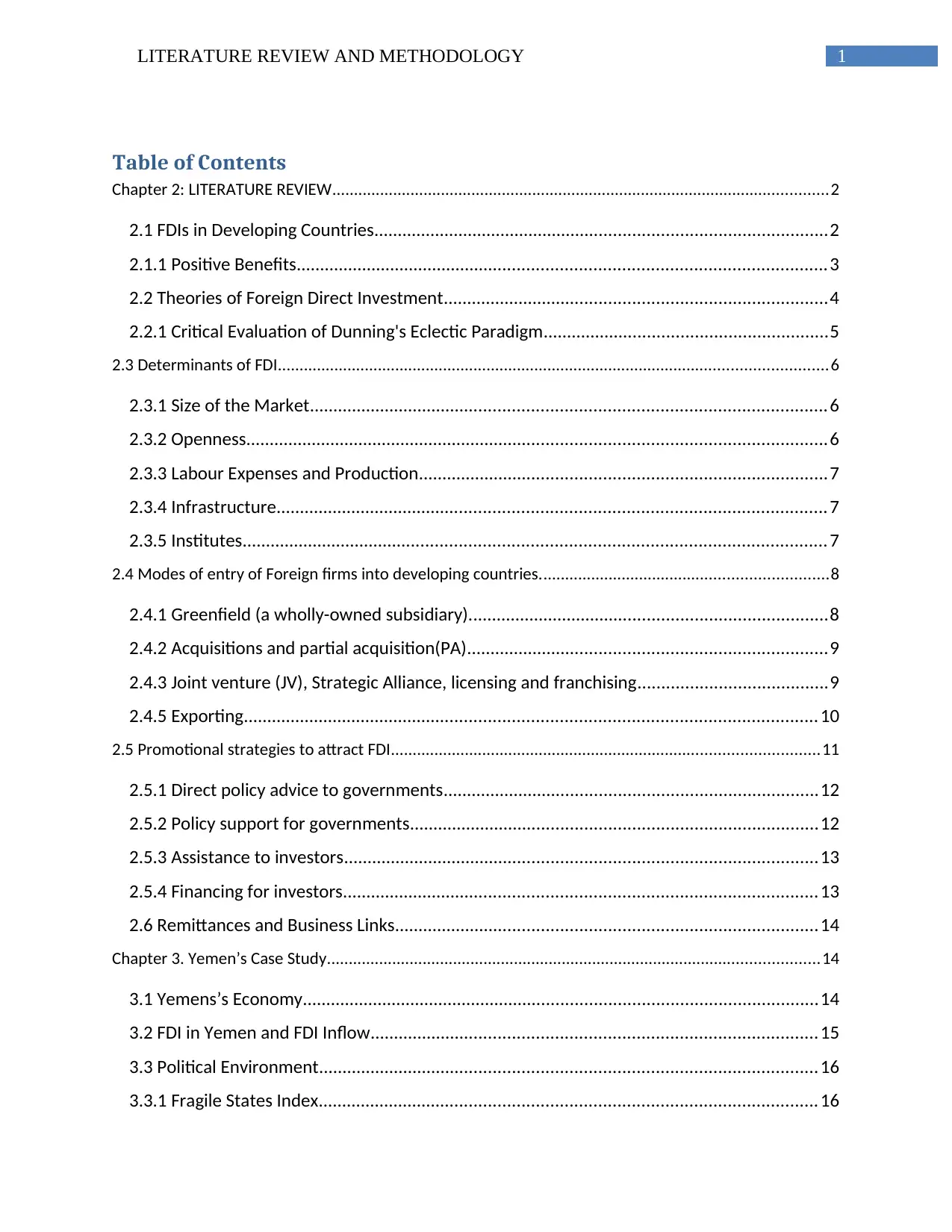
1LITERATURE REVIEW AND METHODOLOGY
Table of Contents
Chapter 2: LITERATURE REVIEW..................................................................................................................2
2.1 FDIs in Developing Countries................................................................................................2
2.1.1 Positive Benefits................................................................................................................3
2.2 Theories of Foreign Direct Investment.................................................................................4
2.2.1 Critical Evaluation of Dunning's Eclectic Paradigm............................................................5
2.3 Determinants of FDI..............................................................................................................................6
2.3.1 Size of the Market.............................................................................................................6
2.3.2 Openness...........................................................................................................................6
2.3.3 Labour Expenses and Production......................................................................................7
2.3.4 Infrastructure.................................................................................................................... 7
2.3.5 Institutes........................................................................................................................... 7
2.4 Modes of entry of Foreign firms into developing countries..................................................................8
2.4.1 Greenfield (a wholly-owned subsidiary)............................................................................8
2.4.2 Acquisitions and partial acquisition(PA)............................................................................9
2.4.3 Joint venture (JV), Strategic Alliance, licensing and franchising........................................9
2.4.5 Exporting......................................................................................................................... 10
2.5 Promotional strategies to attract FDI..................................................................................................11
2.5.1 Direct policy advice to governments...............................................................................12
2.5.2 Policy support for governments......................................................................................12
2.5.3 Assistance to investors....................................................................................................13
2.5.4 Financing for investors....................................................................................................13
2.6 Remittances and Business Links.........................................................................................14
Chapter 3. Yemen’s Case Study.................................................................................................................14
3.1 Yemens’s Economy.............................................................................................................14
3.2 FDI in Yemen and FDI Inflow.............................................................................................. 15
3.3 Political Environment......................................................................................................... 16
3.3.1 Fragile States Index......................................................................................................... 16
Table of Contents
Chapter 2: LITERATURE REVIEW..................................................................................................................2
2.1 FDIs in Developing Countries................................................................................................2
2.1.1 Positive Benefits................................................................................................................3
2.2 Theories of Foreign Direct Investment.................................................................................4
2.2.1 Critical Evaluation of Dunning's Eclectic Paradigm............................................................5
2.3 Determinants of FDI..............................................................................................................................6
2.3.1 Size of the Market.............................................................................................................6
2.3.2 Openness...........................................................................................................................6
2.3.3 Labour Expenses and Production......................................................................................7
2.3.4 Infrastructure.................................................................................................................... 7
2.3.5 Institutes........................................................................................................................... 7
2.4 Modes of entry of Foreign firms into developing countries..................................................................8
2.4.1 Greenfield (a wholly-owned subsidiary)............................................................................8
2.4.2 Acquisitions and partial acquisition(PA)............................................................................9
2.4.3 Joint venture (JV), Strategic Alliance, licensing and franchising........................................9
2.4.5 Exporting......................................................................................................................... 10
2.5 Promotional strategies to attract FDI..................................................................................................11
2.5.1 Direct policy advice to governments...............................................................................12
2.5.2 Policy support for governments......................................................................................12
2.5.3 Assistance to investors....................................................................................................13
2.5.4 Financing for investors....................................................................................................13
2.6 Remittances and Business Links.........................................................................................14
Chapter 3. Yemen’s Case Study.................................................................................................................14
3.1 Yemens’s Economy.............................................................................................................14
3.2 FDI in Yemen and FDI Inflow.............................................................................................. 15
3.3 Political Environment......................................................................................................... 16
3.3.1 Fragile States Index......................................................................................................... 16
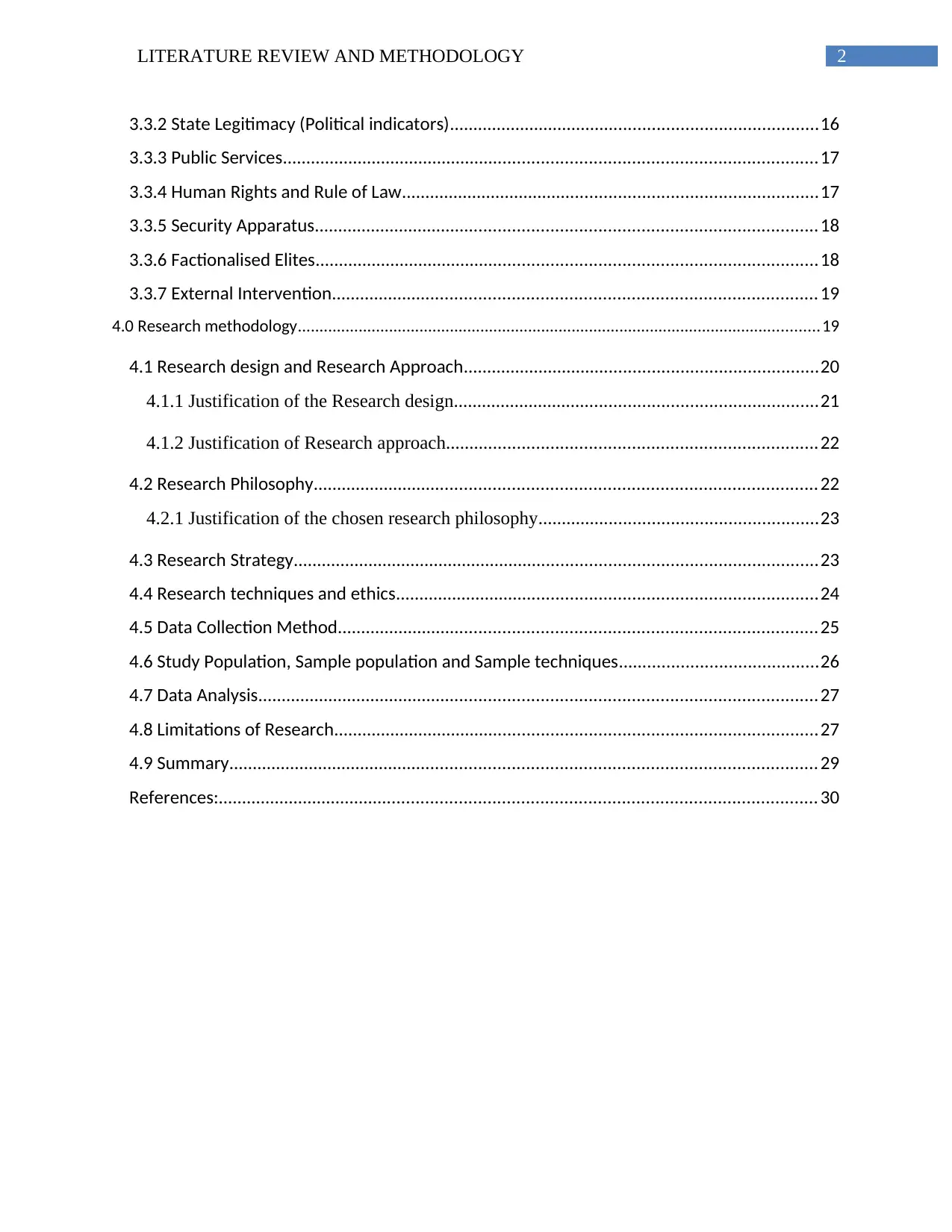
2LITERATURE REVIEW AND METHODOLOGY
3.3.2 State Legitimacy (Political indicators)..............................................................................16
3.3.3 Public Services.................................................................................................................17
3.3.4 Human Rights and Rule of Law........................................................................................17
3.3.5 Security Apparatus..........................................................................................................18
3.3.6 Factionalised Elites..........................................................................................................18
3.3.7 External Intervention...................................................................................................... 19
4.0 Research methodology........................................................................................................................19
4.1 Research design and Research Approach...........................................................................20
4.1.1 Justification of the Research design.............................................................................21
4.1.2 Justification of Research approach..............................................................................22
4.2 Research Philosophy.......................................................................................................... 22
4.2.1 Justification of the chosen research philosophy...........................................................23
4.3 Research Strategy...............................................................................................................23
4.4 Research techniques and ethics.........................................................................................24
4.5 Data Collection Method..................................................................................................... 25
4.6 Study Population, Sample population and Sample techniques..........................................26
4.7 Data Analysis...................................................................................................................... 27
4.8 Limitations of Research......................................................................................................27
4.9 Summary............................................................................................................................ 29
References:.............................................................................................................................. 30
3.3.2 State Legitimacy (Political indicators)..............................................................................16
3.3.3 Public Services.................................................................................................................17
3.3.4 Human Rights and Rule of Law........................................................................................17
3.3.5 Security Apparatus..........................................................................................................18
3.3.6 Factionalised Elites..........................................................................................................18
3.3.7 External Intervention...................................................................................................... 19
4.0 Research methodology........................................................................................................................19
4.1 Research design and Research Approach...........................................................................20
4.1.1 Justification of the Research design.............................................................................21
4.1.2 Justification of Research approach..............................................................................22
4.2 Research Philosophy.......................................................................................................... 22
4.2.1 Justification of the chosen research philosophy...........................................................23
4.3 Research Strategy...............................................................................................................23
4.4 Research techniques and ethics.........................................................................................24
4.5 Data Collection Method..................................................................................................... 25
4.6 Study Population, Sample population and Sample techniques..........................................26
4.7 Data Analysis...................................................................................................................... 27
4.8 Limitations of Research......................................................................................................27
4.9 Summary............................................................................................................................ 29
References:.............................................................................................................................. 30
⊘ This is a preview!⊘
Do you want full access?
Subscribe today to unlock all pages.

Trusted by 1+ million students worldwide
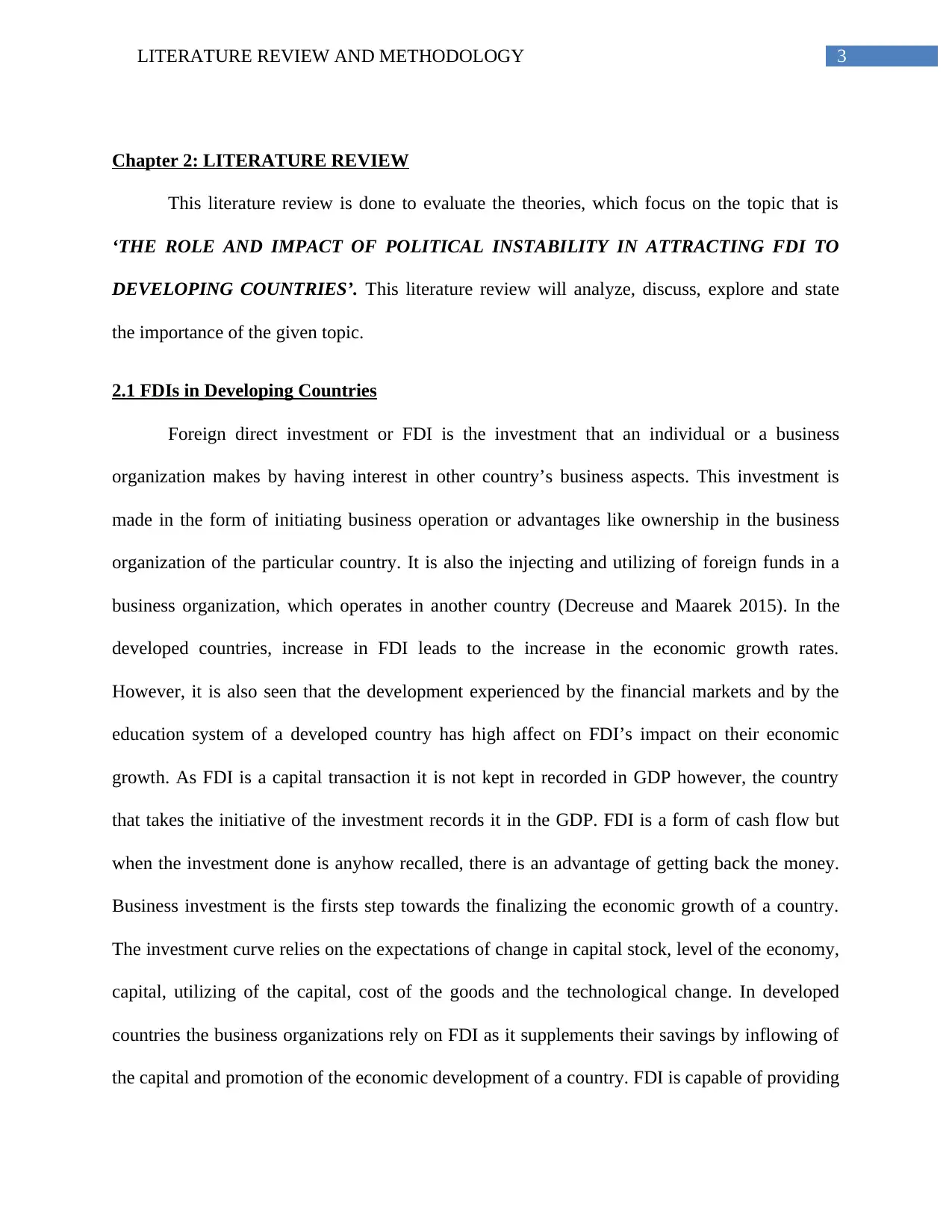
3LITERATURE REVIEW AND METHODOLOGY
Chapter 2: LITERATURE REVIEW
This literature review is done to evaluate the theories, which focus on the topic that is
‘THE ROLE AND IMPACT OF POLITICAL INSTABILITY IN ATTRACTING FDI TO
DEVELOPING COUNTRIES’. This literature review will analyze, discuss, explore and state
the importance of the given topic.
2.1 FDIs in Developing Countries
Foreign direct investment or FDI is the investment that an individual or a business
organization makes by having interest in other country’s business aspects. This investment is
made in the form of initiating business operation or advantages like ownership in the business
organization of the particular country. It is also the injecting and utilizing of foreign funds in a
business organization, which operates in another country (Decreuse and Maarek 2015). In the
developed countries, increase in FDI leads to the increase in the economic growth rates.
However, it is also seen that the development experienced by the financial markets and by the
education system of a developed country has high affect on FDI’s impact on their economic
growth. As FDI is a capital transaction it is not kept in recorded in GDP however, the country
that takes the initiative of the investment records it in the GDP. FDI is a form of cash flow but
when the investment done is anyhow recalled, there is an advantage of getting back the money.
Business investment is the firsts step towards the finalizing the economic growth of a country.
The investment curve relies on the expectations of change in capital stock, level of the economy,
capital, utilizing of the capital, cost of the goods and the technological change. In developed
countries the business organizations rely on FDI as it supplements their savings by inflowing of
the capital and promotion of the economic development of a country. FDI is capable of providing
Chapter 2: LITERATURE REVIEW
This literature review is done to evaluate the theories, which focus on the topic that is
‘THE ROLE AND IMPACT OF POLITICAL INSTABILITY IN ATTRACTING FDI TO
DEVELOPING COUNTRIES’. This literature review will analyze, discuss, explore and state
the importance of the given topic.
2.1 FDIs in Developing Countries
Foreign direct investment or FDI is the investment that an individual or a business
organization makes by having interest in other country’s business aspects. This investment is
made in the form of initiating business operation or advantages like ownership in the business
organization of the particular country. It is also the injecting and utilizing of foreign funds in a
business organization, which operates in another country (Decreuse and Maarek 2015). In the
developed countries, increase in FDI leads to the increase in the economic growth rates.
However, it is also seen that the development experienced by the financial markets and by the
education system of a developed country has high affect on FDI’s impact on their economic
growth. As FDI is a capital transaction it is not kept in recorded in GDP however, the country
that takes the initiative of the investment records it in the GDP. FDI is a form of cash flow but
when the investment done is anyhow recalled, there is an advantage of getting back the money.
Business investment is the firsts step towards the finalizing the economic growth of a country.
The investment curve relies on the expectations of change in capital stock, level of the economy,
capital, utilizing of the capital, cost of the goods and the technological change. In developed
countries the business organizations rely on FDI as it supplements their savings by inflowing of
the capital and promotion of the economic development of a country. FDI is capable of providing
Paraphrase This Document
Need a fresh take? Get an instant paraphrase of this document with our AI Paraphraser
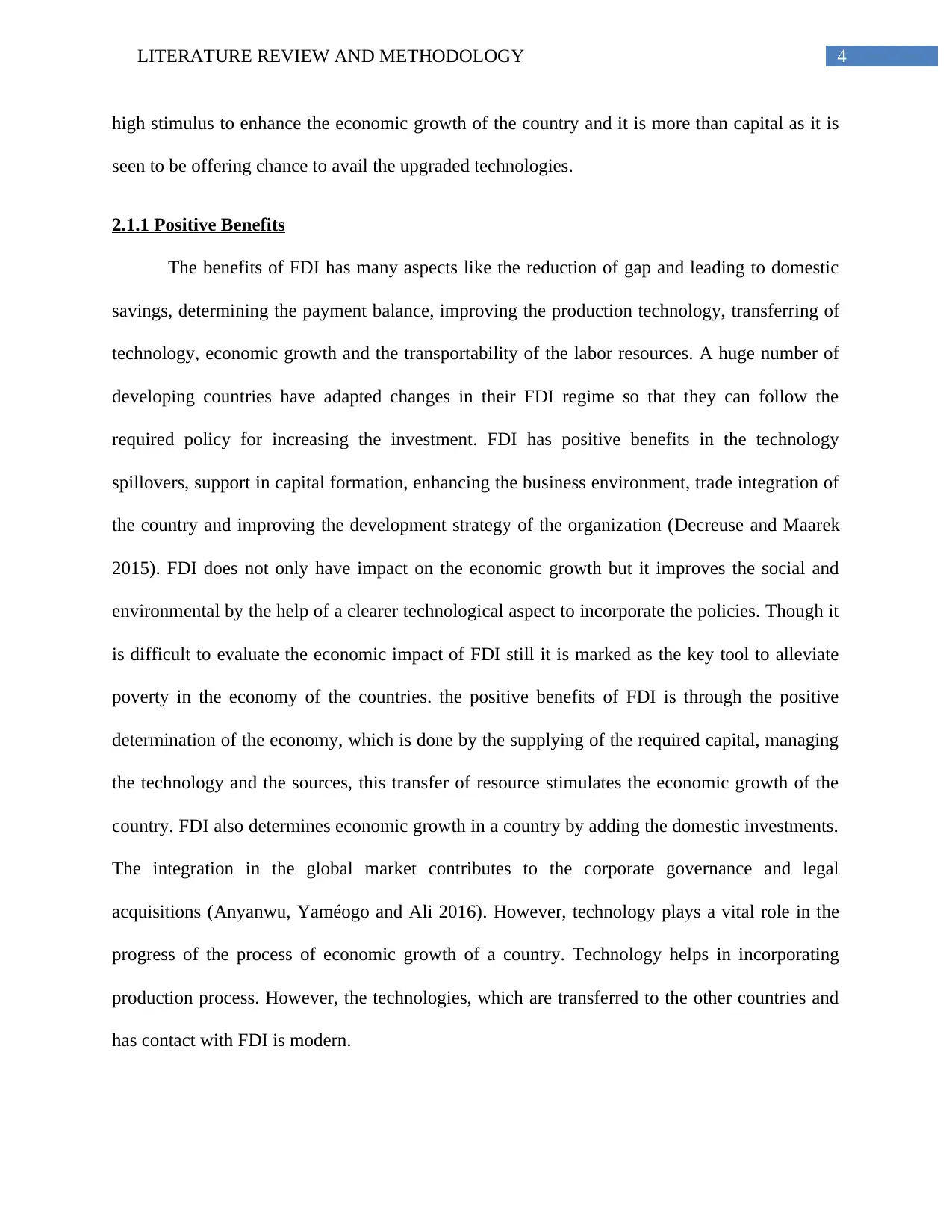
4LITERATURE REVIEW AND METHODOLOGY
high stimulus to enhance the economic growth of the country and it is more than capital as it is
seen to be offering chance to avail the upgraded technologies.
2.1.1 Positive Benefits
The benefits of FDI has many aspects like the reduction of gap and leading to domestic
savings, determining the payment balance, improving the production technology, transferring of
technology, economic growth and the transportability of the labor resources. A huge number of
developing countries have adapted changes in their FDI regime so that they can follow the
required policy for increasing the investment. FDI has positive benefits in the technology
spillovers, support in capital formation, enhancing the business environment, trade integration of
the country and improving the development strategy of the organization (Decreuse and Maarek
2015). FDI does not only have impact on the economic growth but it improves the social and
environmental by the help of a clearer technological aspect to incorporate the policies. Though it
is difficult to evaluate the economic impact of FDI still it is marked as the key tool to alleviate
poverty in the economy of the countries. the positive benefits of FDI is through the positive
determination of the economy, which is done by the supplying of the required capital, managing
the technology and the sources, this transfer of resource stimulates the economic growth of the
country. FDI also determines economic growth in a country by adding the domestic investments.
The integration in the global market contributes to the corporate governance and legal
acquisitions (Anyanwu, Yaméogo and Ali 2016). However, technology plays a vital role in the
progress of the process of economic growth of a country. Technology helps in incorporating
production process. However, the technologies, which are transferred to the other countries and
has contact with FDI is modern.
high stimulus to enhance the economic growth of the country and it is more than capital as it is
seen to be offering chance to avail the upgraded technologies.
2.1.1 Positive Benefits
The benefits of FDI has many aspects like the reduction of gap and leading to domestic
savings, determining the payment balance, improving the production technology, transferring of
technology, economic growth and the transportability of the labor resources. A huge number of
developing countries have adapted changes in their FDI regime so that they can follow the
required policy for increasing the investment. FDI has positive benefits in the technology
spillovers, support in capital formation, enhancing the business environment, trade integration of
the country and improving the development strategy of the organization (Decreuse and Maarek
2015). FDI does not only have impact on the economic growth but it improves the social and
environmental by the help of a clearer technological aspect to incorporate the policies. Though it
is difficult to evaluate the economic impact of FDI still it is marked as the key tool to alleviate
poverty in the economy of the countries. the positive benefits of FDI is through the positive
determination of the economy, which is done by the supplying of the required capital, managing
the technology and the sources, this transfer of resource stimulates the economic growth of the
country. FDI also determines economic growth in a country by adding the domestic investments.
The integration in the global market contributes to the corporate governance and legal
acquisitions (Anyanwu, Yaméogo and Ali 2016). However, technology plays a vital role in the
progress of the process of economic growth of a country. Technology helps in incorporating
production process. However, the technologies, which are transferred to the other countries and
has contact with FDI is modern.
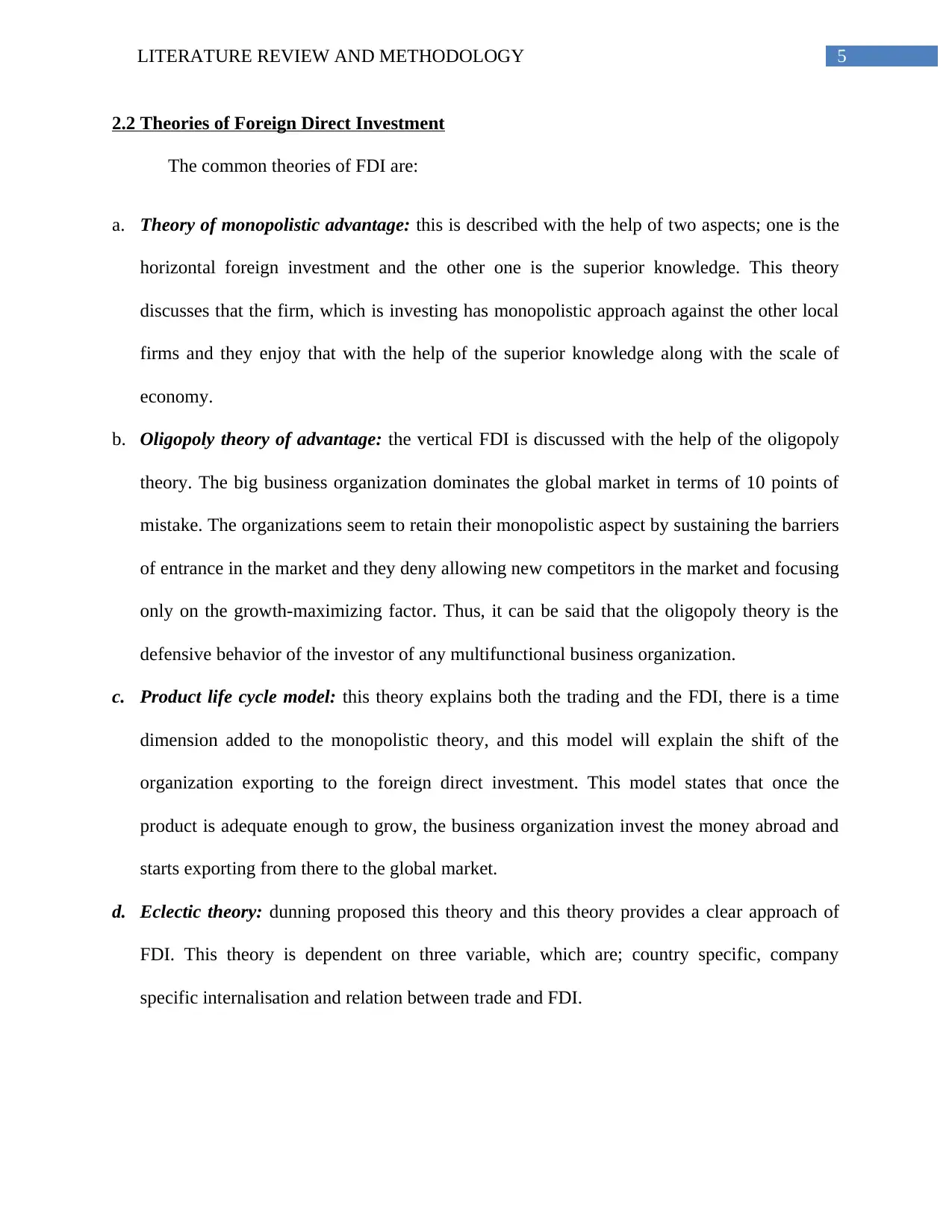
5LITERATURE REVIEW AND METHODOLOGY
2.2 Theories of Foreign Direct Investment
The common theories of FDI are:
a. Theory of monopolistic advantage: this is described with the help of two aspects; one is the
horizontal foreign investment and the other one is the superior knowledge. This theory
discusses that the firm, which is investing has monopolistic approach against the other local
firms and they enjoy that with the help of the superior knowledge along with the scale of
economy.
b. Oligopoly theory of advantage: the vertical FDI is discussed with the help of the oligopoly
theory. The big business organization dominates the global market in terms of 10 points of
mistake. The organizations seem to retain their monopolistic aspect by sustaining the barriers
of entrance in the market and they deny allowing new competitors in the market and focusing
only on the growth-maximizing factor. Thus, it can be said that the oligopoly theory is the
defensive behavior of the investor of any multifunctional business organization.
c. Product life cycle model: this theory explains both the trading and the FDI, there is a time
dimension added to the monopolistic theory, and this model will explain the shift of the
organization exporting to the foreign direct investment. This model states that once the
product is adequate enough to grow, the business organization invest the money abroad and
starts exporting from there to the global market.
d. Eclectic theory: dunning proposed this theory and this theory provides a clear approach of
FDI. This theory is dependent on three variable, which are; country specific, company
specific internalisation and relation between trade and FDI.
2.2 Theories of Foreign Direct Investment
The common theories of FDI are:
a. Theory of monopolistic advantage: this is described with the help of two aspects; one is the
horizontal foreign investment and the other one is the superior knowledge. This theory
discusses that the firm, which is investing has monopolistic approach against the other local
firms and they enjoy that with the help of the superior knowledge along with the scale of
economy.
b. Oligopoly theory of advantage: the vertical FDI is discussed with the help of the oligopoly
theory. The big business organization dominates the global market in terms of 10 points of
mistake. The organizations seem to retain their monopolistic aspect by sustaining the barriers
of entrance in the market and they deny allowing new competitors in the market and focusing
only on the growth-maximizing factor. Thus, it can be said that the oligopoly theory is the
defensive behavior of the investor of any multifunctional business organization.
c. Product life cycle model: this theory explains both the trading and the FDI, there is a time
dimension added to the monopolistic theory, and this model will explain the shift of the
organization exporting to the foreign direct investment. This model states that once the
product is adequate enough to grow, the business organization invest the money abroad and
starts exporting from there to the global market.
d. Eclectic theory: dunning proposed this theory and this theory provides a clear approach of
FDI. This theory is dependent on three variable, which are; country specific, company
specific internalisation and relation between trade and FDI.
⊘ This is a preview!⊘
Do you want full access?
Subscribe today to unlock all pages.

Trusted by 1+ million students worldwide
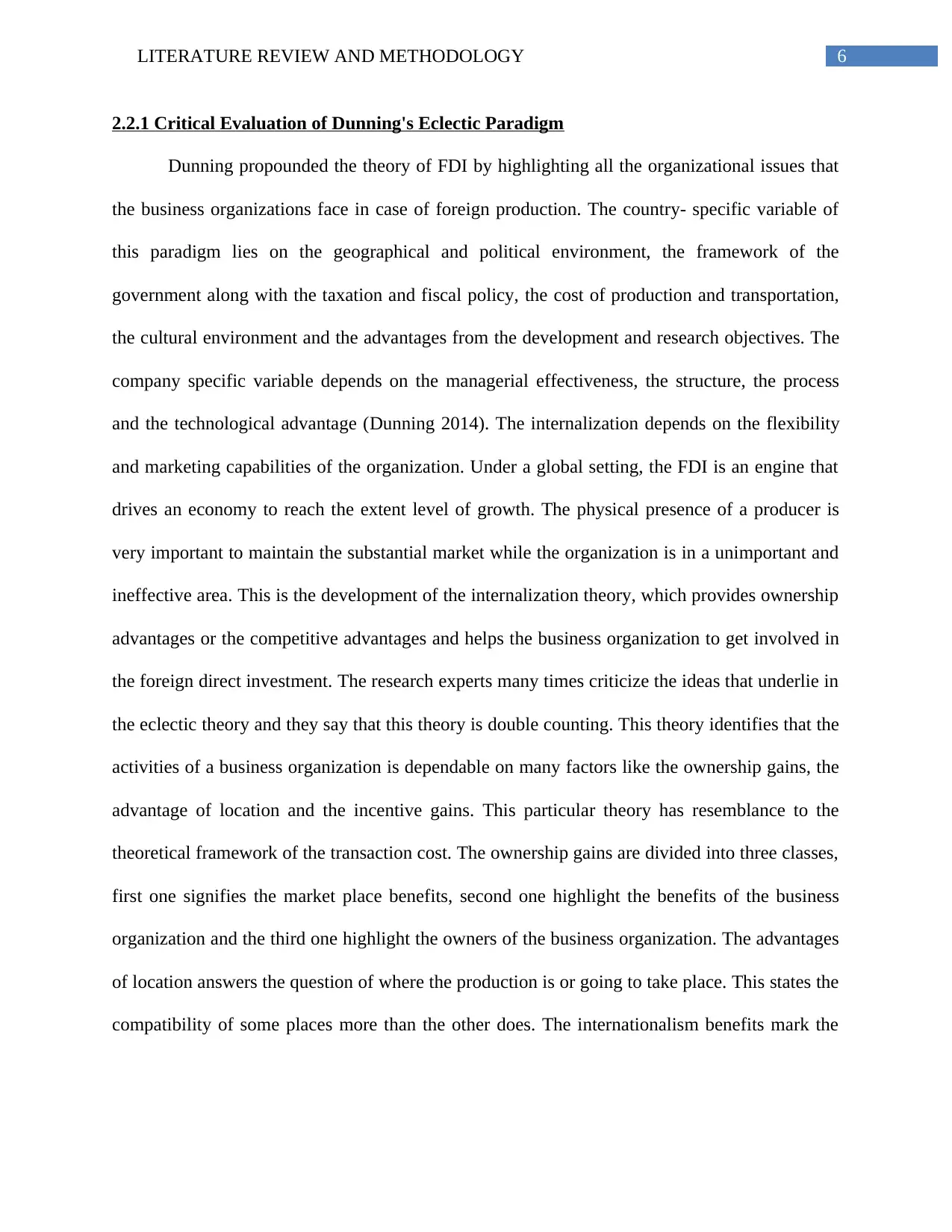
6LITERATURE REVIEW AND METHODOLOGY
2.2.1 Critical Evaluation of Dunning's Eclectic Paradigm
Dunning propounded the theory of FDI by highlighting all the organizational issues that
the business organizations face in case of foreign production. The country- specific variable of
this paradigm lies on the geographical and political environment, the framework of the
government along with the taxation and fiscal policy, the cost of production and transportation,
the cultural environment and the advantages from the development and research objectives. The
company specific variable depends on the managerial effectiveness, the structure, the process
and the technological advantage (Dunning 2014). The internalization depends on the flexibility
and marketing capabilities of the organization. Under a global setting, the FDI is an engine that
drives an economy to reach the extent level of growth. The physical presence of a producer is
very important to maintain the substantial market while the organization is in a unimportant and
ineffective area. This is the development of the internalization theory, which provides ownership
advantages or the competitive advantages and helps the business organization to get involved in
the foreign direct investment. The research experts many times criticize the ideas that underlie in
the eclectic theory and they say that this theory is double counting. This theory identifies that the
activities of a business organization is dependable on many factors like the ownership gains, the
advantage of location and the incentive gains. This particular theory has resemblance to the
theoretical framework of the transaction cost. The ownership gains are divided into three classes,
first one signifies the market place benefits, second one highlight the benefits of the business
organization and the third one highlight the owners of the business organization. The advantages
of location answers the question of where the production is or going to take place. This states the
compatibility of some places more than the other does. The internationalism benefits mark the
2.2.1 Critical Evaluation of Dunning's Eclectic Paradigm
Dunning propounded the theory of FDI by highlighting all the organizational issues that
the business organizations face in case of foreign production. The country- specific variable of
this paradigm lies on the geographical and political environment, the framework of the
government along with the taxation and fiscal policy, the cost of production and transportation,
the cultural environment and the advantages from the development and research objectives. The
company specific variable depends on the managerial effectiveness, the structure, the process
and the technological advantage (Dunning 2014). The internalization depends on the flexibility
and marketing capabilities of the organization. Under a global setting, the FDI is an engine that
drives an economy to reach the extent level of growth. The physical presence of a producer is
very important to maintain the substantial market while the organization is in a unimportant and
ineffective area. This is the development of the internalization theory, which provides ownership
advantages or the competitive advantages and helps the business organization to get involved in
the foreign direct investment. The research experts many times criticize the ideas that underlie in
the eclectic theory and they say that this theory is double counting. This theory identifies that the
activities of a business organization is dependable on many factors like the ownership gains, the
advantage of location and the incentive gains. This particular theory has resemblance to the
theoretical framework of the transaction cost. The ownership gains are divided into three classes,
first one signifies the market place benefits, second one highlight the benefits of the business
organization and the third one highlight the owners of the business organization. The advantages
of location answers the question of where the production is or going to take place. This states the
compatibility of some places more than the other does. The internationalism benefits mark the
Paraphrase This Document
Need a fresh take? Get an instant paraphrase of this document with our AI Paraphraser
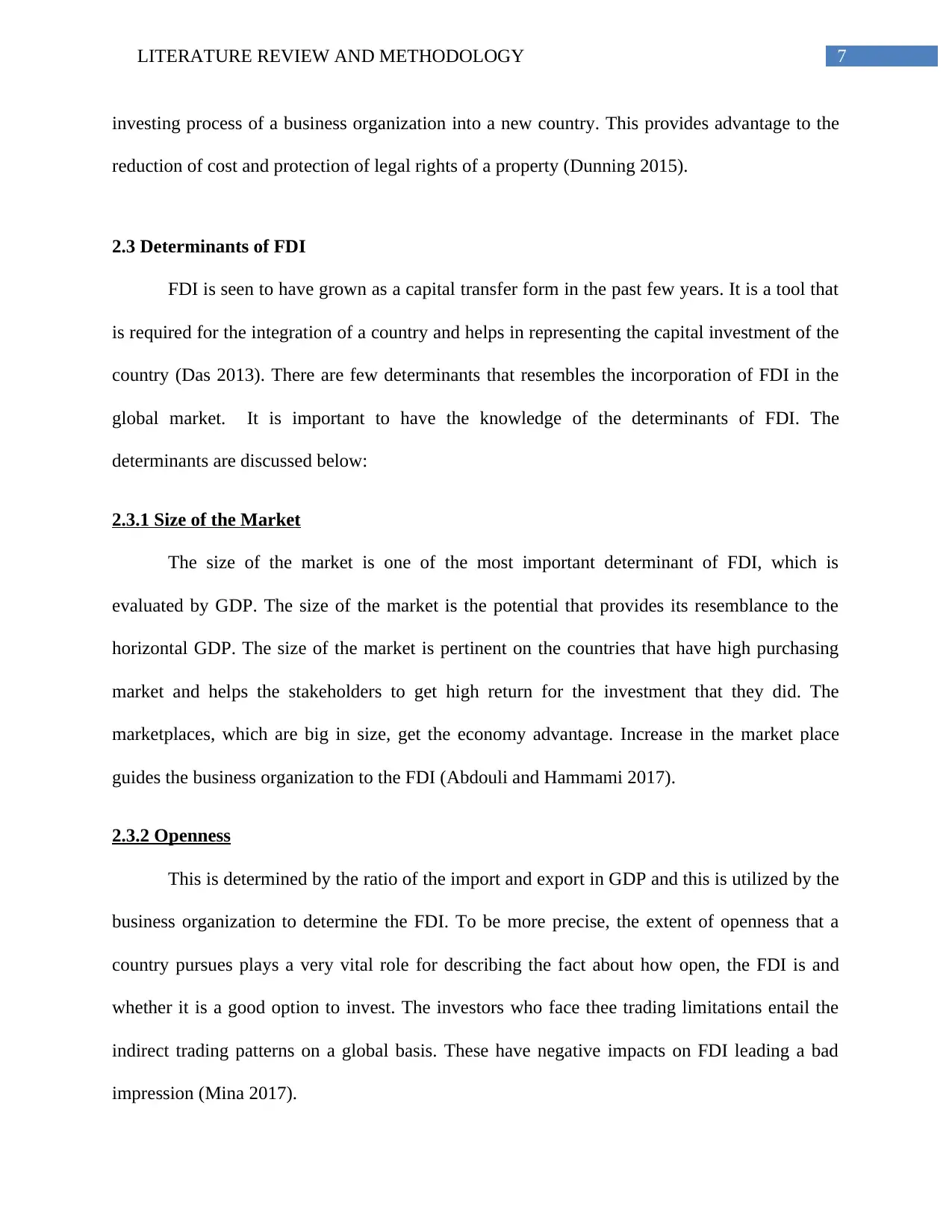
7LITERATURE REVIEW AND METHODOLOGY
investing process of a business organization into a new country. This provides advantage to the
reduction of cost and protection of legal rights of a property (Dunning 2015).
2.3 Determinants of FDI
FDI is seen to have grown as a capital transfer form in the past few years. It is a tool that
is required for the integration of a country and helps in representing the capital investment of the
country (Das 2013). There are few determinants that resembles the incorporation of FDI in the
global market. It is important to have the knowledge of the determinants of FDI. The
determinants are discussed below:
2.3.1 Size of the Market
The size of the market is one of the most important determinant of FDI, which is
evaluated by GDP. The size of the market is the potential that provides its resemblance to the
horizontal GDP. The size of the market is pertinent on the countries that have high purchasing
market and helps the stakeholders to get high return for the investment that they did. The
marketplaces, which are big in size, get the economy advantage. Increase in the market place
guides the business organization to the FDI (Abdouli and Hammami 2017).
2.3.2 Openness
This is determined by the ratio of the import and export in GDP and this is utilized by the
business organization to determine the FDI. To be more precise, the extent of openness that a
country pursues plays a very vital role for describing the fact about how open, the FDI is and
whether it is a good option to invest. The investors who face thee trading limitations entail the
indirect trading patterns on a global basis. These have negative impacts on FDI leading a bad
impression (Mina 2017).
investing process of a business organization into a new country. This provides advantage to the
reduction of cost and protection of legal rights of a property (Dunning 2015).
2.3 Determinants of FDI
FDI is seen to have grown as a capital transfer form in the past few years. It is a tool that
is required for the integration of a country and helps in representing the capital investment of the
country (Das 2013). There are few determinants that resembles the incorporation of FDI in the
global market. It is important to have the knowledge of the determinants of FDI. The
determinants are discussed below:
2.3.1 Size of the Market
The size of the market is one of the most important determinant of FDI, which is
evaluated by GDP. The size of the market is the potential that provides its resemblance to the
horizontal GDP. The size of the market is pertinent on the countries that have high purchasing
market and helps the stakeholders to get high return for the investment that they did. The
marketplaces, which are big in size, get the economy advantage. Increase in the market place
guides the business organization to the FDI (Abdouli and Hammami 2017).
2.3.2 Openness
This is determined by the ratio of the import and export in GDP and this is utilized by the
business organization to determine the FDI. To be more precise, the extent of openness that a
country pursues plays a very vital role for describing the fact about how open, the FDI is and
whether it is a good option to invest. The investors who face thee trading limitations entail the
indirect trading patterns on a global basis. These have negative impacts on FDI leading a bad
impression (Mina 2017).
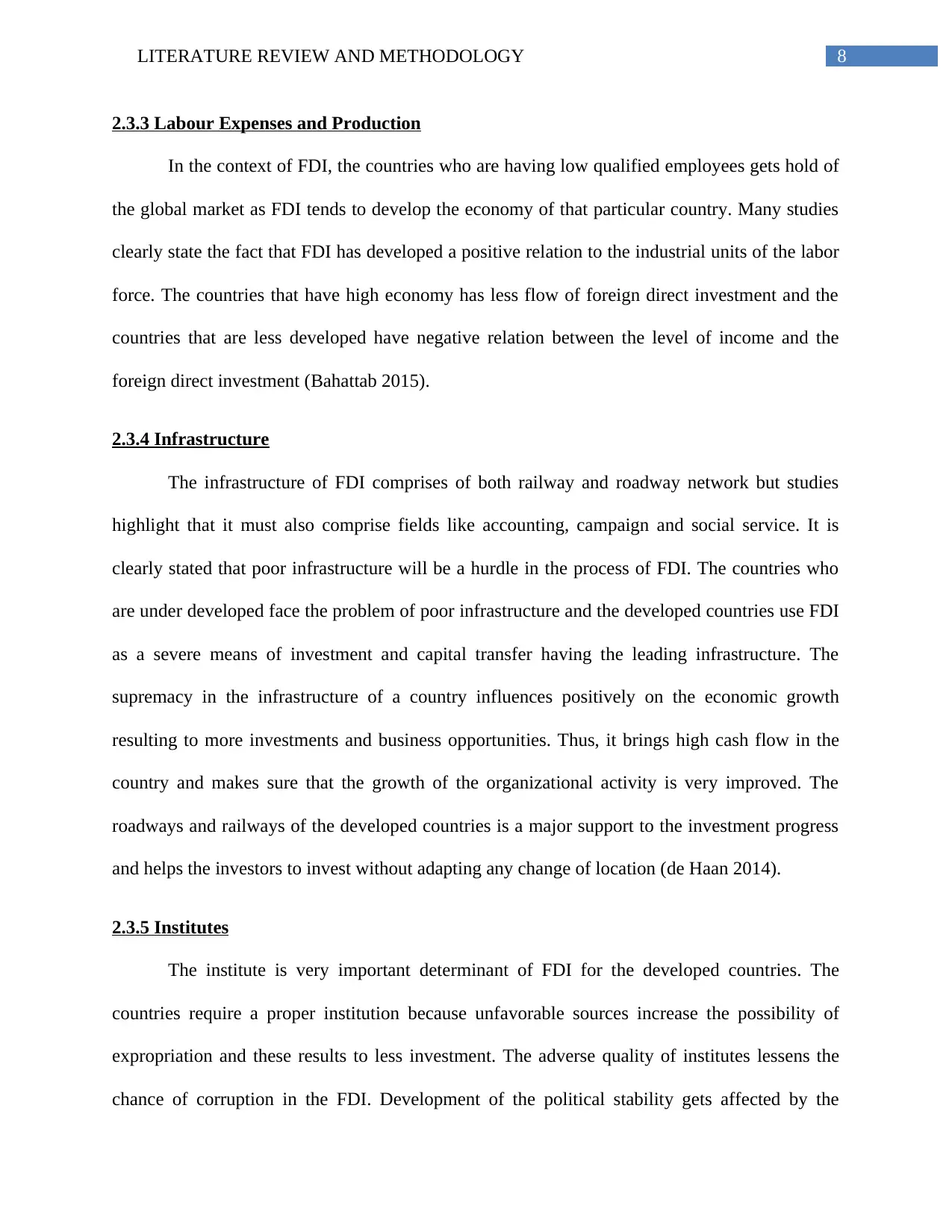
8LITERATURE REVIEW AND METHODOLOGY
2.3.3 Labour Expenses and Production
In the context of FDI, the countries who are having low qualified employees gets hold of
the global market as FDI tends to develop the economy of that particular country. Many studies
clearly state the fact that FDI has developed a positive relation to the industrial units of the labor
force. The countries that have high economy has less flow of foreign direct investment and the
countries that are less developed have negative relation between the level of income and the
foreign direct investment (Bahattab 2015).
2.3.4 Infrastructure
The infrastructure of FDI comprises of both railway and roadway network but studies
highlight that it must also comprise fields like accounting, campaign and social service. It is
clearly stated that poor infrastructure will be a hurdle in the process of FDI. The countries who
are under developed face the problem of poor infrastructure and the developed countries use FDI
as a severe means of investment and capital transfer having the leading infrastructure. The
supremacy in the infrastructure of a country influences positively on the economic growth
resulting to more investments and business opportunities. Thus, it brings high cash flow in the
country and makes sure that the growth of the organizational activity is very improved. The
roadways and railways of the developed countries is a major support to the investment progress
and helps the investors to invest without adapting any change of location (de Haan 2014).
2.3.5 Institutes
The institute is very important determinant of FDI for the developed countries. The
countries require a proper institution because unfavorable sources increase the possibility of
expropriation and these results to less investment. The adverse quality of institutes lessens the
chance of corruption in the FDI. Development of the political stability gets affected by the
2.3.3 Labour Expenses and Production
In the context of FDI, the countries who are having low qualified employees gets hold of
the global market as FDI tends to develop the economy of that particular country. Many studies
clearly state the fact that FDI has developed a positive relation to the industrial units of the labor
force. The countries that have high economy has less flow of foreign direct investment and the
countries that are less developed have negative relation between the level of income and the
foreign direct investment (Bahattab 2015).
2.3.4 Infrastructure
The infrastructure of FDI comprises of both railway and roadway network but studies
highlight that it must also comprise fields like accounting, campaign and social service. It is
clearly stated that poor infrastructure will be a hurdle in the process of FDI. The countries who
are under developed face the problem of poor infrastructure and the developed countries use FDI
as a severe means of investment and capital transfer having the leading infrastructure. The
supremacy in the infrastructure of a country influences positively on the economic growth
resulting to more investments and business opportunities. Thus, it brings high cash flow in the
country and makes sure that the growth of the organizational activity is very improved. The
roadways and railways of the developed countries is a major support to the investment progress
and helps the investors to invest without adapting any change of location (de Haan 2014).
2.3.5 Institutes
The institute is very important determinant of FDI for the developed countries. The
countries require a proper institution because unfavorable sources increase the possibility of
expropriation and these results to less investment. The adverse quality of institutes lessens the
chance of corruption in the FDI. Development of the political stability gets affected by the
⊘ This is a preview!⊘
Do you want full access?
Subscribe today to unlock all pages.

Trusted by 1+ million students worldwide
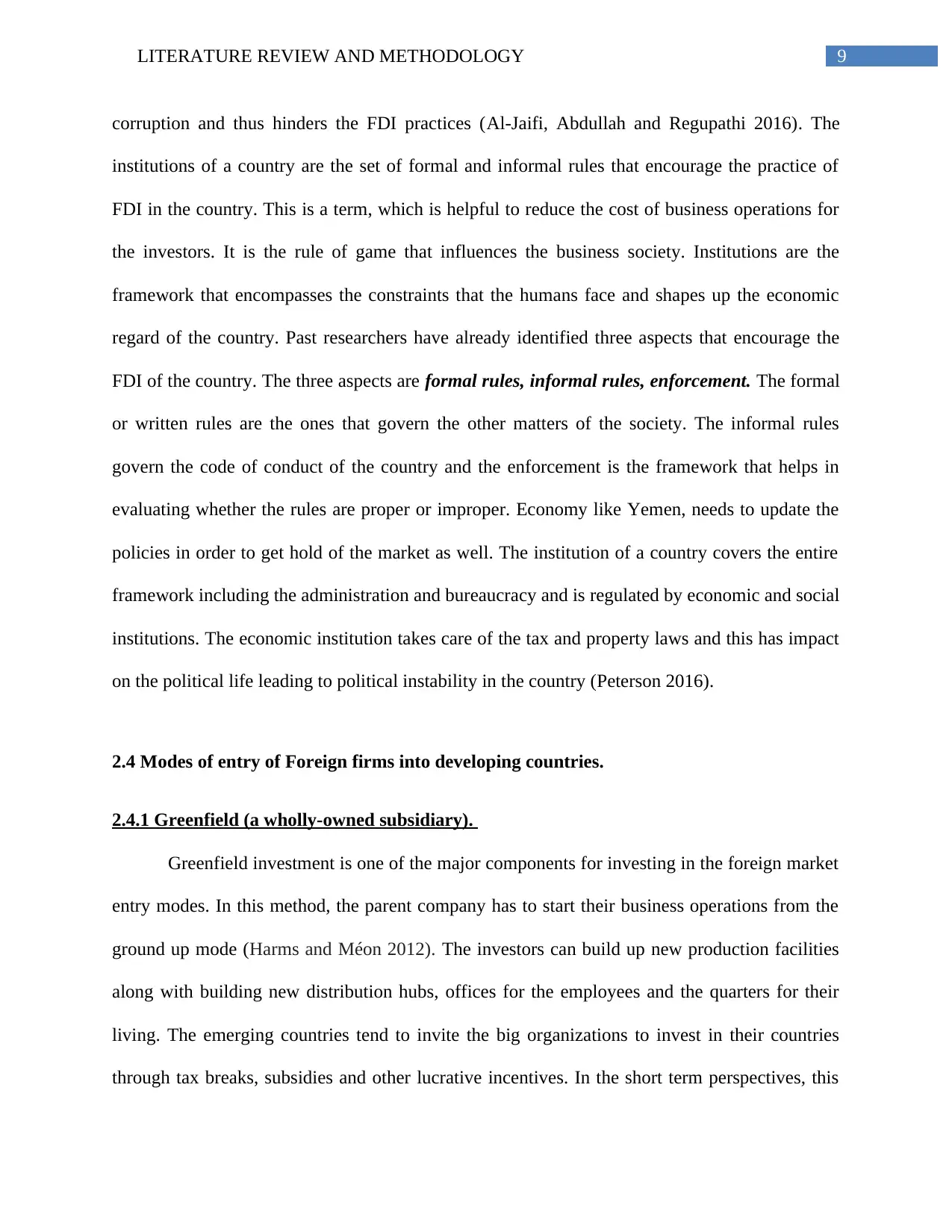
9LITERATURE REVIEW AND METHODOLOGY
corruption and thus hinders the FDI practices (Al-Jaifi, Abdullah and Regupathi 2016). The
institutions of a country are the set of formal and informal rules that encourage the practice of
FDI in the country. This is a term, which is helpful to reduce the cost of business operations for
the investors. It is the rule of game that influences the business society. Institutions are the
framework that encompasses the constraints that the humans face and shapes up the economic
regard of the country. Past researchers have already identified three aspects that encourage the
FDI of the country. The three aspects are formal rules, informal rules, enforcement. The formal
or written rules are the ones that govern the other matters of the society. The informal rules
govern the code of conduct of the country and the enforcement is the framework that helps in
evaluating whether the rules are proper or improper. Economy like Yemen, needs to update the
policies in order to get hold of the market as well. The institution of a country covers the entire
framework including the administration and bureaucracy and is regulated by economic and social
institutions. The economic institution takes care of the tax and property laws and this has impact
on the political life leading to political instability in the country (Peterson 2016).
2.4 Modes of entry of Foreign firms into developing countries.
2.4.1 Greenfield (a wholly-owned subsidiary).
Greenfield investment is one of the major components for investing in the foreign market
entry modes. In this method, the parent company has to start their business operations from the
ground up mode (Harms and Méon 2012). The investors can build up new production facilities
along with building new distribution hubs, offices for the employees and the quarters for their
living. The emerging countries tend to invite the big organizations to invest in their countries
through tax breaks, subsidies and other lucrative incentives. In the short term perspectives, this
corruption and thus hinders the FDI practices (Al-Jaifi, Abdullah and Regupathi 2016). The
institutions of a country are the set of formal and informal rules that encourage the practice of
FDI in the country. This is a term, which is helpful to reduce the cost of business operations for
the investors. It is the rule of game that influences the business society. Institutions are the
framework that encompasses the constraints that the humans face and shapes up the economic
regard of the country. Past researchers have already identified three aspects that encourage the
FDI of the country. The three aspects are formal rules, informal rules, enforcement. The formal
or written rules are the ones that govern the other matters of the society. The informal rules
govern the code of conduct of the country and the enforcement is the framework that helps in
evaluating whether the rules are proper or improper. Economy like Yemen, needs to update the
policies in order to get hold of the market as well. The institution of a country covers the entire
framework including the administration and bureaucracy and is regulated by economic and social
institutions. The economic institution takes care of the tax and property laws and this has impact
on the political life leading to political instability in the country (Peterson 2016).
2.4 Modes of entry of Foreign firms into developing countries.
2.4.1 Greenfield (a wholly-owned subsidiary).
Greenfield investment is one of the major components for investing in the foreign market
entry modes. In this method, the parent company has to start their business operations from the
ground up mode (Harms and Méon 2012). The investors can build up new production facilities
along with building new distribution hubs, offices for the employees and the quarters for their
living. The emerging countries tend to invite the big organizations to invest in their countries
through tax breaks, subsidies and other lucrative incentives. In the short term perspectives, this
Paraphrase This Document
Need a fresh take? Get an instant paraphrase of this document with our AI Paraphraser
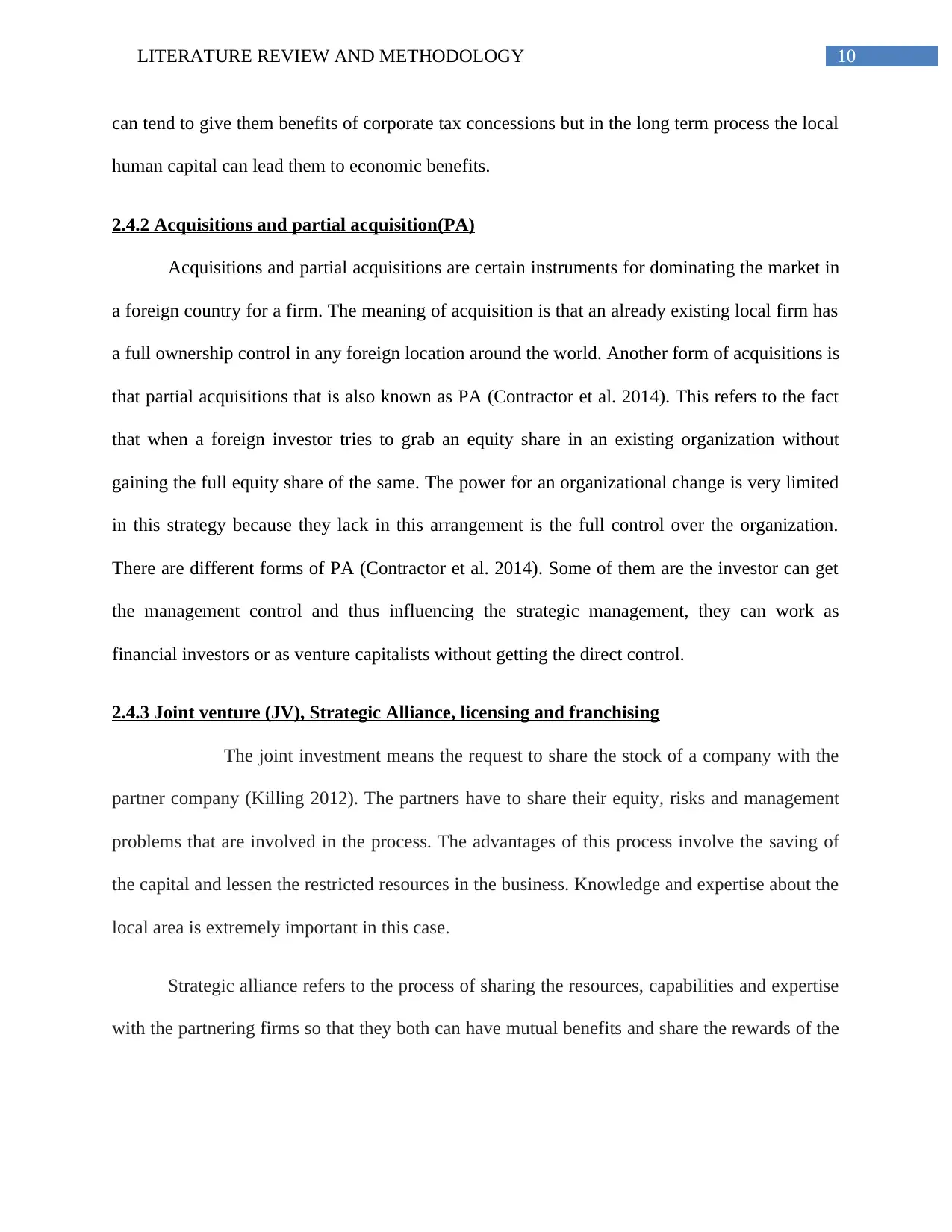
10LITERATURE REVIEW AND METHODOLOGY
can tend to give them benefits of corporate tax concessions but in the long term process the local
human capital can lead them to economic benefits.
2.4.2 Acquisitions and partial acquisition(PA)
Acquisitions and partial acquisitions are certain instruments for dominating the market in
a foreign country for a firm. The meaning of acquisition is that an already existing local firm has
a full ownership control in any foreign location around the world. Another form of acquisitions is
that partial acquisitions that is also known as PA (Contractor et al. 2014). This refers to the fact
that when a foreign investor tries to grab an equity share in an existing organization without
gaining the full equity share of the same. The power for an organizational change is very limited
in this strategy because they lack in this arrangement is the full control over the organization.
There are different forms of PA (Contractor et al. 2014). Some of them are the investor can get
the management control and thus influencing the strategic management, they can work as
financial investors or as venture capitalists without getting the direct control.
2.4.3 Joint venture (JV), Strategic Alliance, licensing and franchising
The joint investment means the request to share the stock of a company with the
partner company (Killing 2012). The partners have to share their equity, risks and management
problems that are involved in the process. The advantages of this process involve the saving of
the capital and lessen the restricted resources in the business. Knowledge and expertise about the
local area is extremely important in this case.
Strategic alliance refers to the process of sharing the resources, capabilities and expertise
with the partnering firms so that they both can have mutual benefits and share the rewards of the
can tend to give them benefits of corporate tax concessions but in the long term process the local
human capital can lead them to economic benefits.
2.4.2 Acquisitions and partial acquisition(PA)
Acquisitions and partial acquisitions are certain instruments for dominating the market in
a foreign country for a firm. The meaning of acquisition is that an already existing local firm has
a full ownership control in any foreign location around the world. Another form of acquisitions is
that partial acquisitions that is also known as PA (Contractor et al. 2014). This refers to the fact
that when a foreign investor tries to grab an equity share in an existing organization without
gaining the full equity share of the same. The power for an organizational change is very limited
in this strategy because they lack in this arrangement is the full control over the organization.
There are different forms of PA (Contractor et al. 2014). Some of them are the investor can get
the management control and thus influencing the strategic management, they can work as
financial investors or as venture capitalists without getting the direct control.
2.4.3 Joint venture (JV), Strategic Alliance, licensing and franchising
The joint investment means the request to share the stock of a company with the
partner company (Killing 2012). The partners have to share their equity, risks and management
problems that are involved in the process. The advantages of this process involve the saving of
the capital and lessen the restricted resources in the business. Knowledge and expertise about the
local area is extremely important in this case.
Strategic alliance refers to the process of sharing the resources, capabilities and expertise
with the partnering firms so that they both can have mutual benefits and share the rewards of the
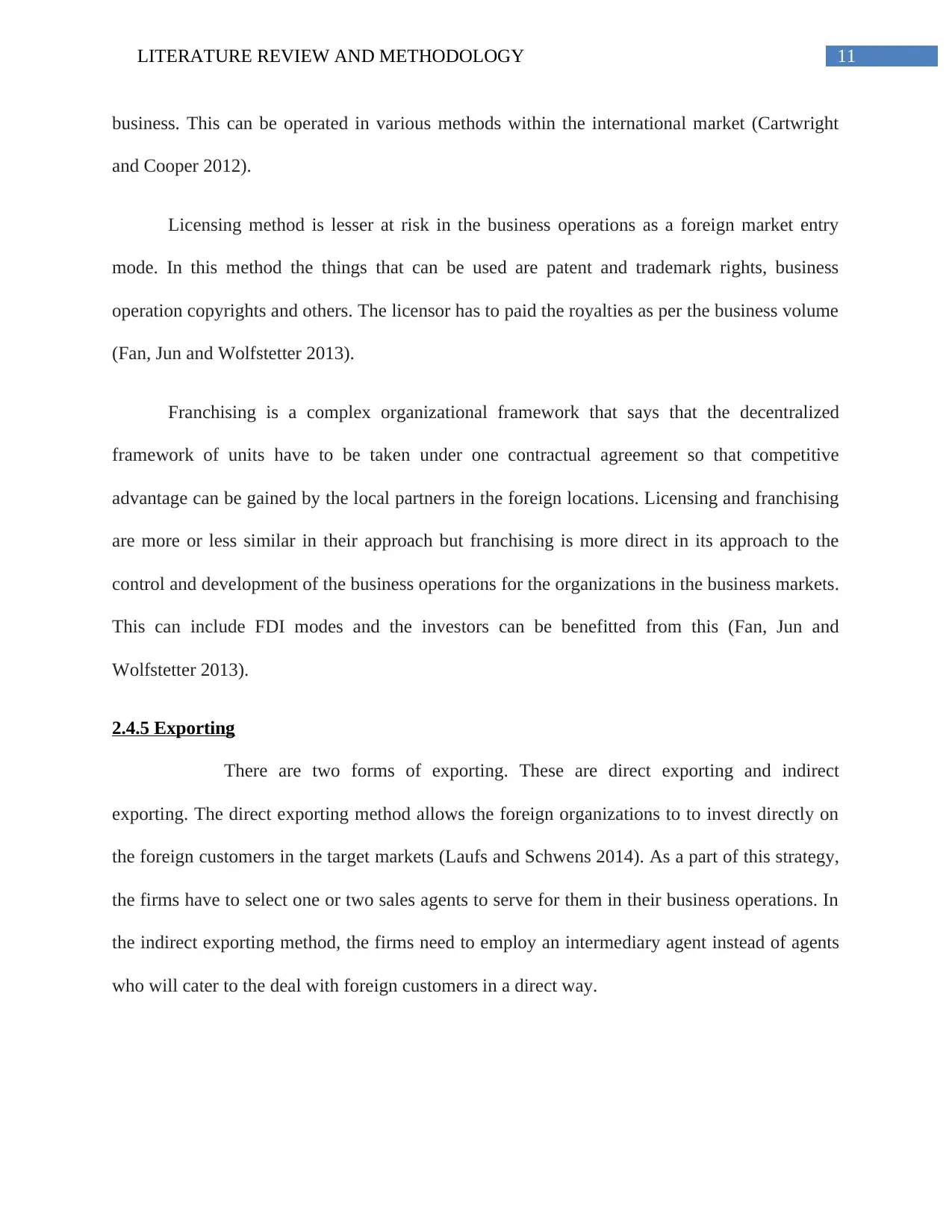
11LITERATURE REVIEW AND METHODOLOGY
business. This can be operated in various methods within the international market (Cartwright
and Cooper 2012).
Licensing method is lesser at risk in the business operations as a foreign market entry
mode. In this method the things that can be used are patent and trademark rights, business
operation copyrights and others. The licensor has to paid the royalties as per the business volume
(Fan, Jun and Wolfstetter 2013).
Franchising is a complex organizational framework that says that the decentralized
framework of units have to be taken under one contractual agreement so that competitive
advantage can be gained by the local partners in the foreign locations. Licensing and franchising
are more or less similar in their approach but franchising is more direct in its approach to the
control and development of the business operations for the organizations in the business markets.
This can include FDI modes and the investors can be benefitted from this (Fan, Jun and
Wolfstetter 2013).
2.4.5 Exporting
There are two forms of exporting. These are direct exporting and indirect
exporting. The direct exporting method allows the foreign organizations to to invest directly on
the foreign customers in the target markets (Laufs and Schwens 2014). As a part of this strategy,
the firms have to select one or two sales agents to serve for them in their business operations. In
the indirect exporting method, the firms need to employ an intermediary agent instead of agents
who will cater to the deal with foreign customers in a direct way.
business. This can be operated in various methods within the international market (Cartwright
and Cooper 2012).
Licensing method is lesser at risk in the business operations as a foreign market entry
mode. In this method the things that can be used are patent and trademark rights, business
operation copyrights and others. The licensor has to paid the royalties as per the business volume
(Fan, Jun and Wolfstetter 2013).
Franchising is a complex organizational framework that says that the decentralized
framework of units have to be taken under one contractual agreement so that competitive
advantage can be gained by the local partners in the foreign locations. Licensing and franchising
are more or less similar in their approach but franchising is more direct in its approach to the
control and development of the business operations for the organizations in the business markets.
This can include FDI modes and the investors can be benefitted from this (Fan, Jun and
Wolfstetter 2013).
2.4.5 Exporting
There are two forms of exporting. These are direct exporting and indirect
exporting. The direct exporting method allows the foreign organizations to to invest directly on
the foreign customers in the target markets (Laufs and Schwens 2014). As a part of this strategy,
the firms have to select one or two sales agents to serve for them in their business operations. In
the indirect exporting method, the firms need to employ an intermediary agent instead of agents
who will cater to the deal with foreign customers in a direct way.
⊘ This is a preview!⊘
Do you want full access?
Subscribe today to unlock all pages.

Trusted by 1+ million students worldwide
1 out of 37
Related Documents
Your All-in-One AI-Powered Toolkit for Academic Success.
+13062052269
info@desklib.com
Available 24*7 on WhatsApp / Email
![[object Object]](/_next/static/media/star-bottom.7253800d.svg)
Unlock your academic potential
Copyright © 2020–2025 A2Z Services. All Rights Reserved. Developed and managed by ZUCOL.





